Ugo Rondinone
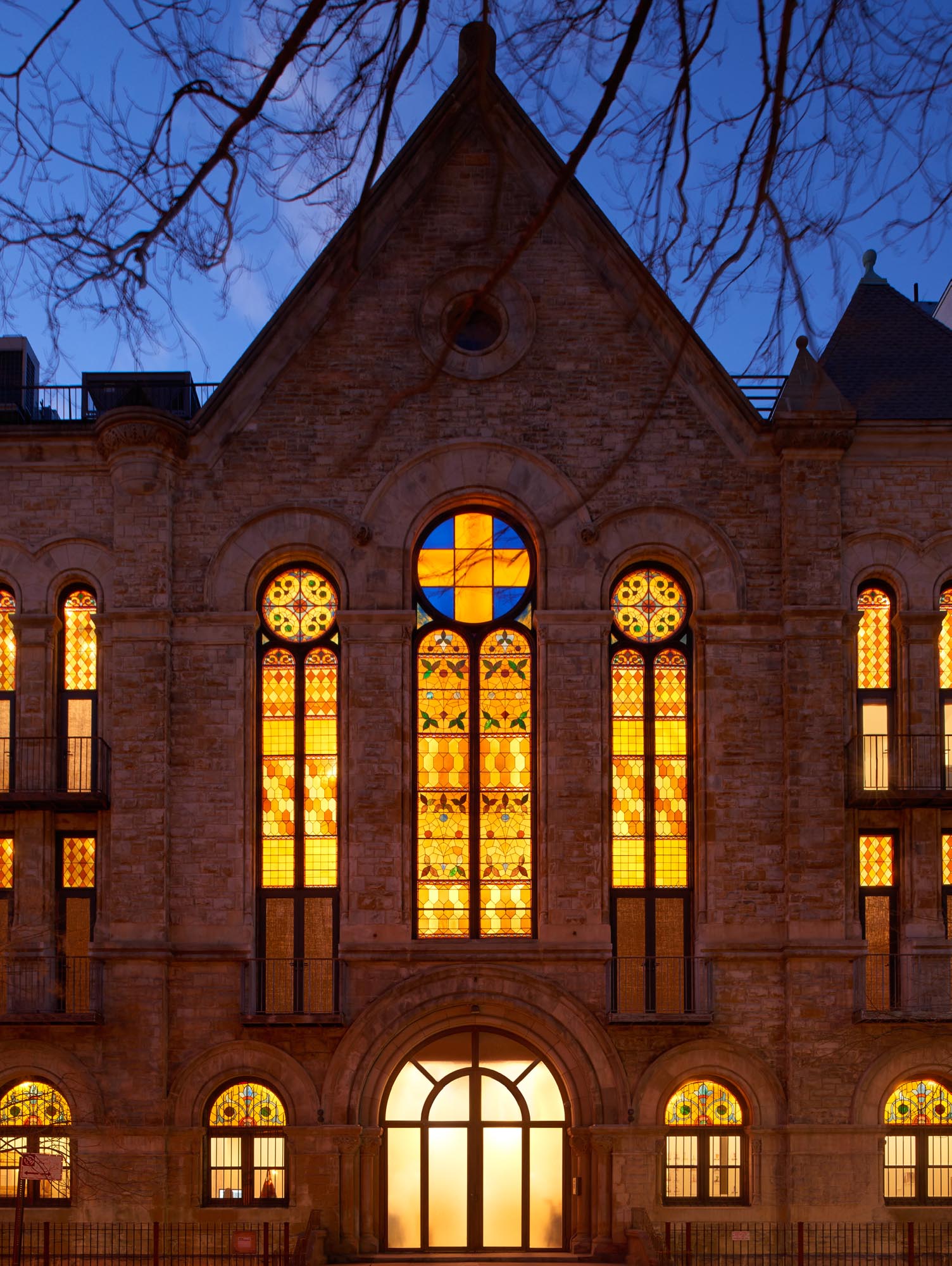
The glowing night-time facade of the former Harlem Mount Moriah Baptist Church, built in 1887 and designed by architect Henry Franklin Kilburn, now a home, studio and exhibition space.
The story begins. A Swiss-born American artist with an international reputation and an urgent, resilient and instinctive desire to make art is driving around Upper Manhattan in 2011 when, in the heart of Harlem, he sees − and he is a fierce seer in both senses − the vaguely Romanesque-style Mount Moriah Baptist Church, once a great gospel center but now badly needing restoration, with a For Sale sign up front. The last thing this artist needs is another house: he already has a loft on Broadway in the East Village and another place somewhere else and also has a diary full of commitments for intricate exhibition projects all over the world. So what does he do? He resists the siren call of the 15,500-square-foot monumental former church, puts pedal to the metal and drives on and away.
Three weeks later the artist, Ugo Rondinone, is lured back by his second sight, and takes another long look at the enormous building, now standing desolate. Reader, he buys it.
What he had let himself in for turned out to be a massive restoration job, far bigger than he had envisaged, but with his spectacular verve, nerve, massive energy and creative strategy he has turned this relic into a thriving sanctuary of art, divided into living and working quarters on a grand scale, its palatial interior lit by high stained-glass windows. It’s now his main residence, his live, work and play place for the making of his own work, for planning the exhibitions of that work, for the exhibitions he curates all over the world and also for the exhibitions of other artists’ work. To add to the general mash-up of cultural production the basement has smaller studios for a rotating cast of visiting artists of diverse disciplines.
Eighty per cent of his work is produced here in this building. There are ten people in the studios and in his office and he is very hands-on. In one room the architectural models that he has made to render what and how he wants everything to look, in the galleries and museums that will show his work, are miniature works of art in themselves. He is almost brisk in his perfectionism, and every proposal, what he conceives and places in these models, is exactly how the finished work will look. Not a centimeter out of place.
In the big chapel room is a startling installation of theatrical illusion – forty-five hyper-realist clowns, red noses and all, dressed in the colors of the rainbow (a recurrent emblem and motif in his work) are occupied, as it were, in sleeping, daydreaming, waking up, sitting, running, lying drooping or slumped. They are truly fantastical and are part of his solo show “The Vocabulary of Solitude” that opened in Rotterdam in 2016. These frighteningly lifelike wasted figures are not in any way comic. And their original function as commentators on life, like Lear’s Fool, is hardly evident here – the traditional idea of a fool being a wise outsider with a cynical and melancholic eye has been exhausted out. The clown is a recurrent figure in Rondinone’s work and appears in his performances, installations, videos and sculptures, an archetypal example of how his work zigzags across the boundaries between fantasy and reality, despair and hope, autobiography and fiction.
Every room has a distinct function but the whole is satiated, saturated, instinctive with art, and so is Ugo Rondinone. “He’s lovely,” an artist friend warns me, “but he is very aggressive in his love of art.” Indeed, art seems as necessary to Rondinone as oxygen is to the lungs. “I need art just to breathe,” he says, simply and without pretension, and with no visible sign of aggression on his interested face. “It’s an on-going spiritual experience – being surrounded by these people,” he gestures towards the many people in the atelier, “and art energizes me. Art plays a lot with inherent forces that you don’t see.” He seems to be able to unpack the power of these forces. His vision, energy and fanatical purpose have crashed together like tectonic plates and just being inside this space, with its quasi-religious sensation of awe, its firework of echoes from wall to wall, makes one react to the immediate present or even to feel a little ahead of it. As he says himself, “Good art revolutionizes your whole being. It is something that stops you, or slows you down.”
He works in a wide range of disciplines and media – installation, photography, sculpture, painting, sound, video and drawing, and it ranges from rugged and monumental and anthropomorphic to delicate and small. He also writes poetry. His works are in the collections of many museums and have been the subject of solo exhibitions at the Whitechapel Gallery in London, the Museum of Contemporary Art in Sydney, the Kunsthalle Vienna, the Musée d’Art Moderne, Centre Georges Pompidou in Paris, not to mention the intriguingly named Louisiana Museum of Modern Art in Humlebaek, Denmark. (Why is a museum in Denmark called Louisiana? Because the house that is now the museum was built by a Danish officer and Master of the Royal Hunt who married three women all named Louise.) Rondinone (with Urs Fischer) also represented Switzerland at the 2007 Venice Biennale.
The route to his eminence was not easy. He was born in 1964 to Italian parents in Brunnen in Switzerland, and might well have become an art teacher in a school there – that was, he says, the only feasible route open to a young working-class man trying to use his artistic gifts and talents, trying to fulfill his vocation and dream. “There were no schools dedicated to helping and educating young artists,” he says, “though there were plenty of technology colleges and graphic and industrial design places – so, for people like the Giacometti brothers or Jean Tinguely the only option was to emigrate.” “How can this be?” I ask him, astounded. “Perhaps it shows the formality of the Swiss mind,” he says, smiling, and my mind hops back to Orson Welles and cuckoo clocks. In 1983 he had the opportunity to go to Vienna to work with Hermann Nitsch, the Austrian avant-garde artist, working in experimental and multimedia modes, and a year later he enrolled in the University of Applied Arts there.
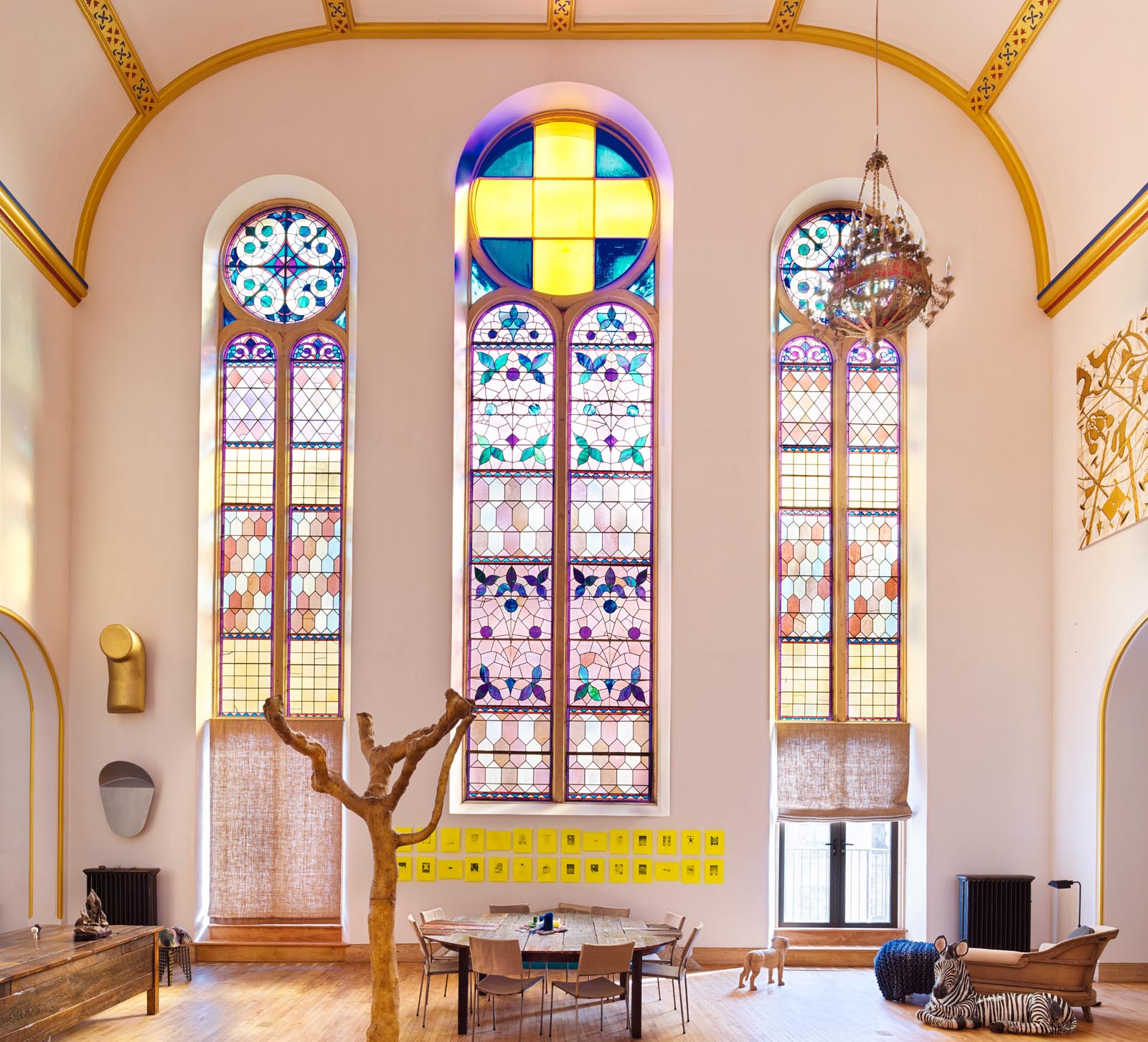
Elegant Romanesque stained-glass windows illuminate the dining area and Ugo Rondinone’s Bright Shiny Morning tree sculpture. On the wall to the left are two Head sculptures by Bruno Gironcoli and underneath the central window are twenty-eight etchings by Paul Thek. An Italian ceramic zebra lies by the chaise longue near to a 20th-century anonymously carved wooden dog (a bit of a rescue one).
In 1998 he moved to New York City and the energy of this city matches his rattling energy. He doesn’t stop working since art is work and his work is his life. “I don’t have family. I have time,” he says simply. “Coming from my background as the child of immigrants, where you keep your head down, you do your best to fit in . . . you have to break out somehow? I needed freedom of expression, a contradictory form to break that pattern. There are two forces behind my work. The dynamic lies in creating opposites; for me it’s the dynamics of Beckettian existence and German romanticism. And whenever I do something in white I have to do it in black. And the foundation of all my work is the natural world – that is the inspirational source.”
So this old temple is a metaphor for his life and work – reaching towards the ideal, making a new meaning from the everyday and from the previous. But every rupture is also continuity; in its previous incarnation this place was a powerhouse for a different kind of belief, and that professing worship of something metaphysical and spiritual lives on.
And not just metaphysically speaking – physically it’s a beautiful place now, especially when viewed from outside at night, lit up like a beacon of light and color.
Inside it may be a theatrical set dedicated to the great drama that is art, but it is also one man’s illuminated domestic space. The main room is spectacularly high and one has to tilt back to squint up at the bizarre chandeliers, original to the building, as are the inset beams gleaming with gilt and color, banding the coved ceiling. The original but startlingly modern-looking stained glass windows, like three great round-headed rockets about to take off, are exemplifications of art installation in themselves and Ugo Rondinone looks out every morning from his bedroom (guarded by a recumbent Italian ceramic zebra that he has had for years) at the light they cast. “The windows face east so every season gives new patterns and different colors. Every morning the light changes the whole room. It’s such a sacred place . . . filled with that kind of energy from down the ages.”
Its shamanistic qualities are perhaps echoed in the scary oil painting hung over his bed – Red Riding Hood & the Wolf, by Verne Dawson, an archetypal work by this American artist who investigates the continuities that persist in human nature and ancient culture. Under the windows are a series of etchings in bright yellow acrylic frames by the painter, sculptor and installation artist Paul Thek, who died in 1988 – they seem almost like a touching memorial to him. Nearby stands Bright Shiny Morning, a tree sculpture in resin, a literal still life by Ugo Rondinone. (A quote from As You Like It arrives unbidden in my head – “He hath strange places cramm’d/With observation, the which he vents/In mangled forms.” But nothing is mangled here. It’s pure and stripped down.)
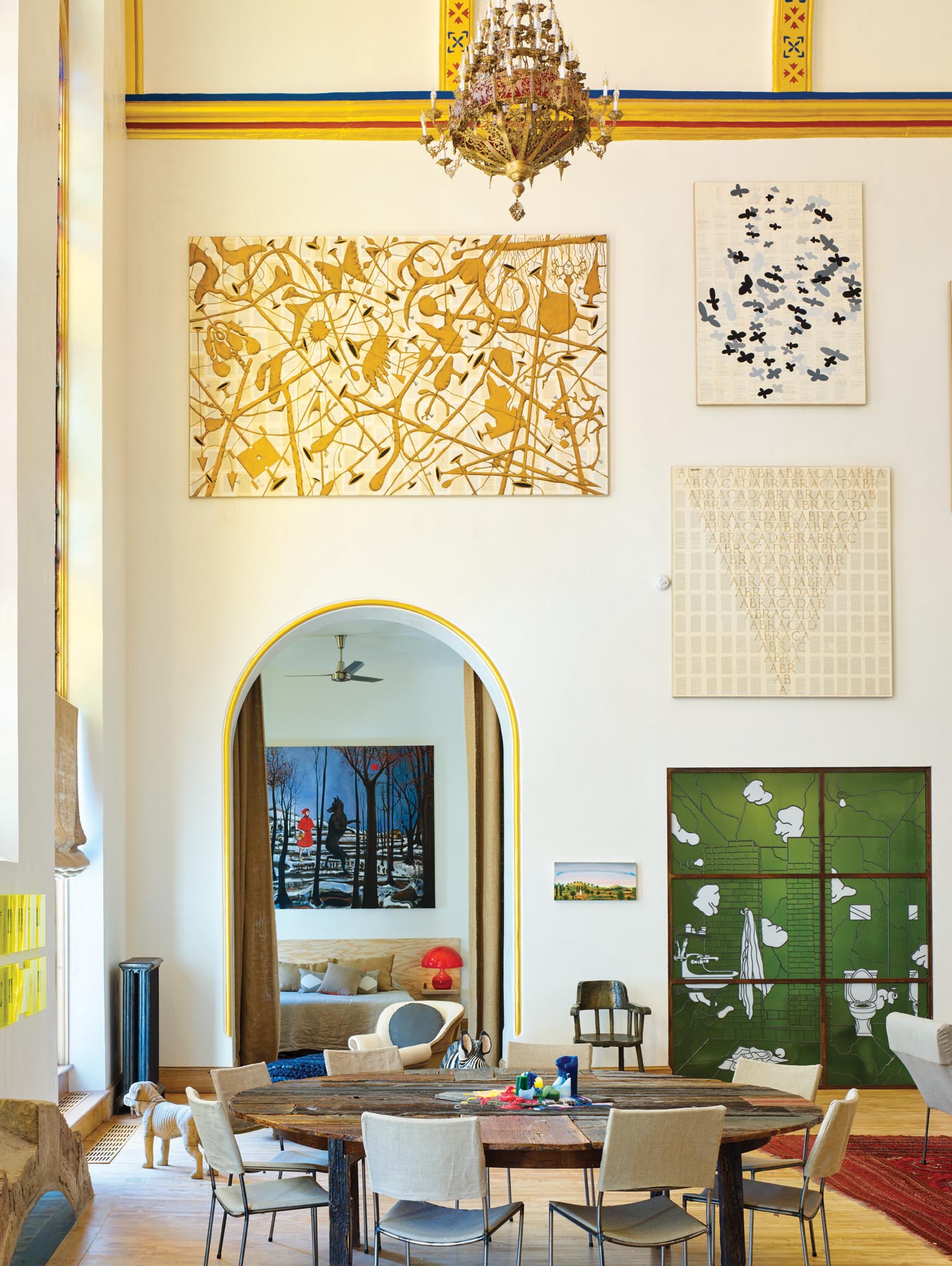
A curtained archway into the bedroom shows Verne Dawson’s Red Riding Hood & the Wolf. Above is Amerika and to its right The Birds II and A Journal of the Plague Year, all by Tim Rollins and K.O.S. Next to the bathroom stained-glass piece, Martin Boyce’s chair sculpture, Anatomy (for Saul Bass) sits below Verne Dawson’s Coronation.
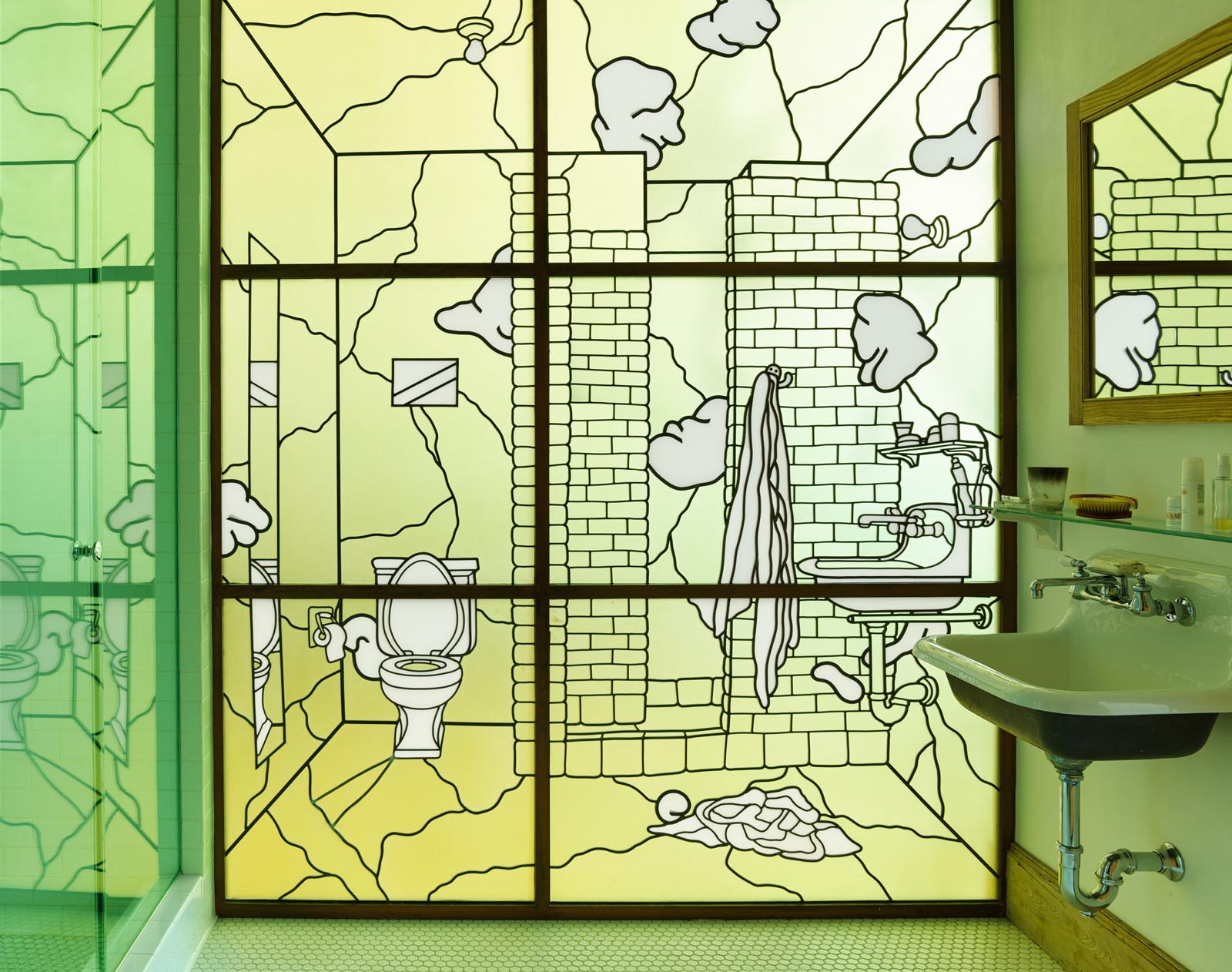
Urs Fischer’s stained-glass representation of Ugo Rondinone’s bathroom, seen here from the bathroom side, is illuminated by the light in the living room.
Above the arched entrance to his bedroom hangs Amerika, a big gold watercolor, book pages on linen made by the joint altruistic enterprise Tim Rollins and K.O.S., Kids of Survival. (I get even more excited, as Tim Rollins and K.O.S. have worked for my husband in England, creating art for his foundation for deprived children.) One wall of his bathroom is a stained-glass representation of a bathroom by Urs Fischer; in fact it’s a perceptual trick that works on many levels, being a meticulous and witty reflection of the real bathroom.
There are other stained-glass windows hidden behind walls to give more space for display, and sculptures and installations stand in carefully curated spaces. But nothing is fixed – you don’t step twice in the same river here. New work arrives often and things are rehung and rearranged. His collection has expanded and is wide ranging. He began by collecting Swiss artists in the early 1990s: “Now 60 per cent of the works in my collection are exchanges with other artists who are my friends.”
On Mondays, Wednesdays and Fridays he has lunches and get-togethers. “Who for? I ask. “Friends? Curators? Art critics? Writers? Artists?” “All of that,” he says. “And people who happen to be passing by?” “No one passes by here,” he says, smiling. I’ve forgotten that though he lives on Fifth Avenue he’s very far uptown, in every sense.
I think if one were asked by an alien culture to make a template to show an energizing example of contemporary art, to convey what its place of creation could look like, to deliver an idea of our strange and mysterious culture, of how artists haul the lyre up in the face of the gods of the underworld, this might well be the place to start.
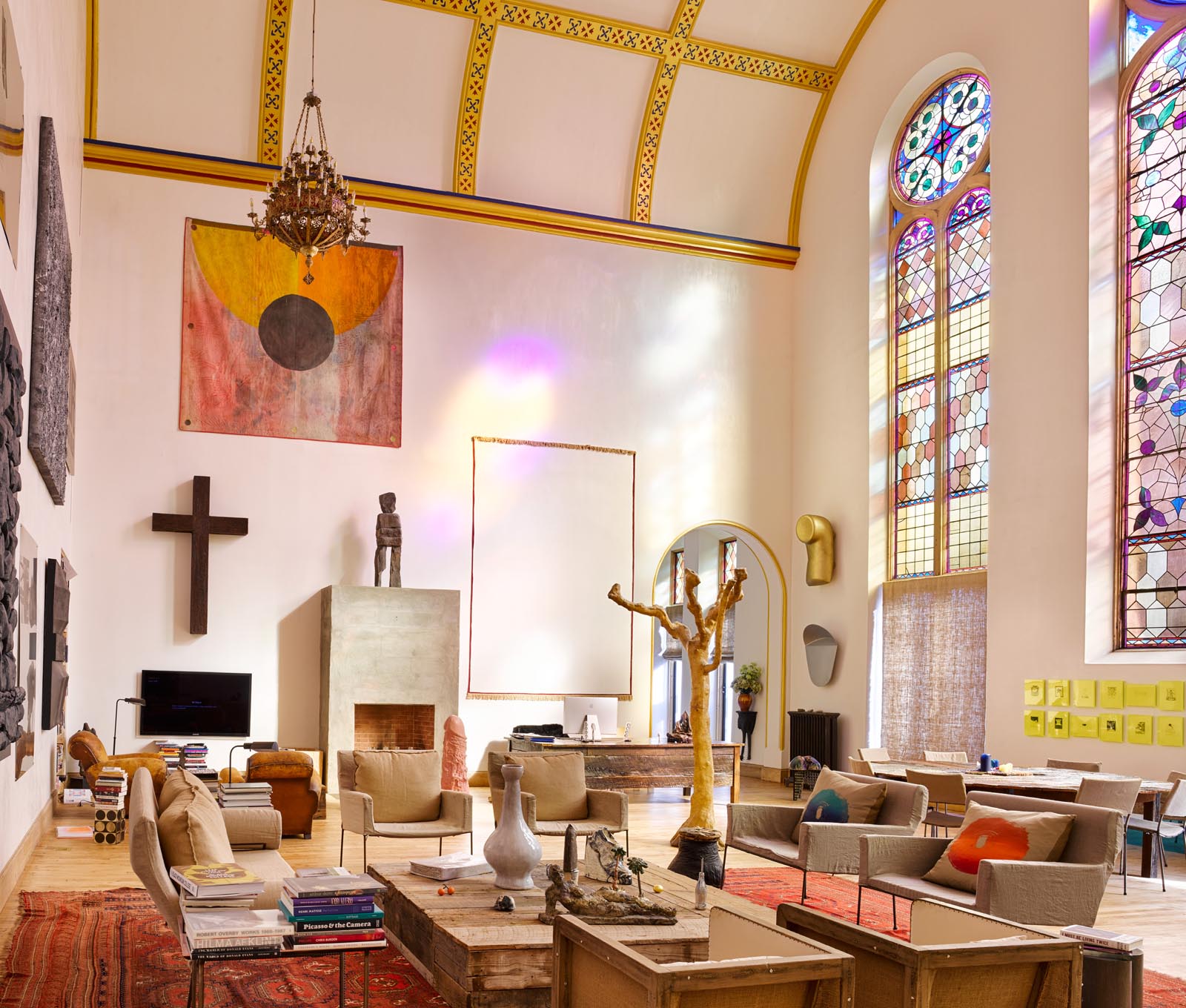
The huge, light-filled living and dining space. On the wall below the coving is Single Swing Encounter by Alan Shields hanging over Valentin Carron’s cross sculpture, I Miss the 20th Century. Above the fireplace stands Ugo Rondinone’s The Tactful and in front of it Sarah Lucas’s Obod Daddy 2. The chairs are by Franz West.